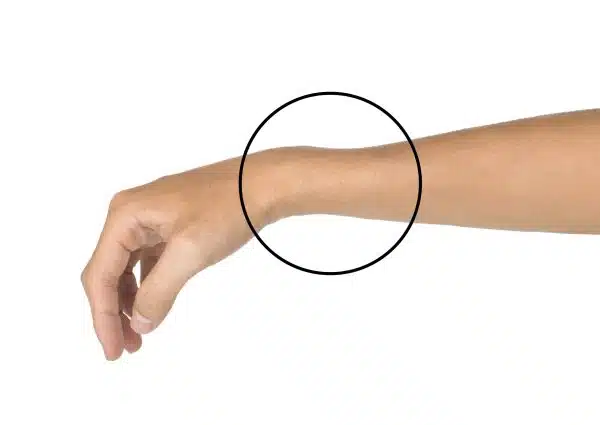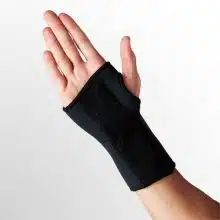Wrist Splint
In Stock
LP Support’s Wrist Splint supports weak or overstretched wrists and also treats carpal tunnel courtesy of its removable spoon stay. Its neoprene construction helps keep the wrist joint warm.

A Colles fracture (or Colles’ fracture) is a fracture of the distal radius in the forearm with dorsal and radial displacement of the wrist and hand. This injury is sometimes known as a “dinner fork” deformity due to the resultant shape of the forearm. Individuals suffering from osteoporosis are especially vulnerable to this injury. It is both an overuse injury and one that can be caused by trauma – usually from trying to break a fall with outstretched hands. Treatment of this injury can require immobilization of the injured area to allow full healing. This may be accomplished by the braces below, although a decision to use one of these products should be taken based on advice from a medical practitioner.
A Colles fracture is a common injury that can have significant implications, particularly in the field of sports medicine. Understanding the causes, recognizing the symptoms, and implementing appropriate treatment strategies are crucial for managing Colles’ fracture and facilitating optimal recovery.
This article aims to provide insights into the causes, symptoms, treatment options, and significance of Colles’ fracture in the context of sports medicine.
Colles’ fractures most commonly result from a fall onto an outstretched hand, typically with the palm facing downward. In sports, the following factors may contribute to the occurrence of Colles’ fracture:
Sports that involve high-impact activities or direct blows to the forearm, such as contact sports or activities like skateboarding or snowboarding, can increase the risk of Colles’ fracture.
Athletes participating in activities with an increased risk of falls, such as gymnastics, skiing, or ice hockey, may be more prone to experiencing Colles’ fractures.
Over time, repetitive stress on the forearm and wrist, such as constant impact or excessive load-bearing activities, can weaken the bones, making them more susceptible to fracture.
The following symptoms are commonly associated with Colles’ fracture:
Immediate pain and swelling around the wrist area are typical after sustaining a Colles’ fracture. The intensity of pain can vary depending on the severity of the fracture.
The fractured area may appear deformed, with visible misalignment or displacement of the wrist bones. This can cause an obvious bump or protrusion on the back of the hand near the wrist.
The ability to move the wrist and hand may be significantly impaired due to pain, swelling, and instability resulting from the fracture.
Bruising and tenderness around the wrist and forearm may be present due to the injury and associated soft tissue trauma.
The treatment approach for Colles’ fracture typically involves the following steps:
To allow for proper healing, the fractured wrist is often immobilized with a cast or splint. The immobilization device helps keep the bones aligned and minimizes movement during the initial healing phase.
If the fracture is displaced or misaligned, the healthcare professional may need to perform a reduction, which involves manually realigning the broken bones to their proper position.
In some cases, particularly for more severe fractures or cases with extensive displacement, surgery may be required. Surgical intervention may involve the use of plates, screws, or pins to stabilize the fracture and aid in proper healing.
After the initial healing period, a rehabilitation program and physical therapy may be recommended to restore wrist and hand function. These exercises help improve range of motion, strength, and flexibility in the affected wrist and hand.
Colles’ fracture is significant in the field of sports medicine due to its potential impact on an athlete’s performance and overall participation in sports activities. The fracture can significantly limit the mobility and function of the wrist and hand, affecting an athlete’s ability to grip, catch, throw, or perform other essential skills specific to their sport.
Prompt diagnosis, appropriate treatment, and comprehensive rehabilitation are vital for athletes to regain optimal wrist and hand function, reduce
The fracture can significantly limit the mobility and function of the wrist and hand, affecting an athlete’s ability to grip, catch, throw, or perform other essential skills specific to their sport. Prompt diagnosis, appropriate treatment, and comprehensive rehabilitation are vital for athletes to regain optimal wrist and hand function, reduce the risk of complications, and safely return to sports activities.
Colles’ fracture is a common wrist fracture that can occur due to falls, trauma, or repetitive stress on the forearm and wrist. Recognizing the causes, symptoms, and treatment options is crucial for effective management of this injury. In the context of sports medicine,
This injury can have significant implications on an athlete’s performance and participation in sports activities. Early diagnosis, appropriate treatment, and comprehensive rehabilitation are key components in facilitating successful recovery and minimizing long-term complications.
Seeking medical attention and adhering to recommended treatment protocols are essential for athletes who experience symptoms of Colles’ fracture.

In Stock
LP Support’s Wrist Splint supports weak or overstretched wrists and also treats carpal tunnel courtesy of its removable spoon stay. Its neoprene construction helps keep the wrist joint warm.